Tabernacle Choir Joins with Band at West Point for Independence Day Celebration
Contributed By R. Scott Lloyd, Church News staff writer

On stage at Trophy Point are the Mormon Tabernacle Choir and West Point Band performing for the Independence Day celebration. In the foreground are members of the newest class of cadets at the military academy.
Related Links
WEST POINT, NEW YORK
For many months, it had been a mysterious and deeply held secret, subject to considerable speculation: What would the Mormon Tabernacle Choir and Orchestra at Temple Square be doing on the July 4 holiday that fell during the groups’ two-week Atlantic Coast tour?
Members were told only that they would perform at a “private event” outside New York City, where they were then staying, and that a “confidential itinerary” would be distributed to them once they had boarded the buses for wherever it was they were going.
Now, on the morning of Independence Day, the answer was uncovered as a prerecorded video was shown just after the 11 buses had departed the Marriott Marquis Hotel in midtown Manhattan: they were bound for the United States Military Academy at West Point.
On the video, administrative manager Barry Anderson told the backstory. Last fall, he received a phone call from a man identifying himself as one of the Boy Scouts over whom Brother Anderson had served as a Scoutmaster about 20 years previously.
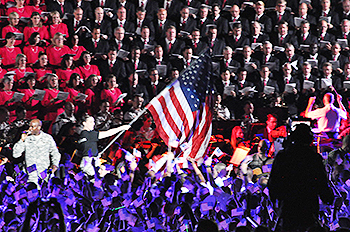
The Mormon Tabernacle Choir, the West Point Band, and the string section from the Orchestra at Temple Square fill the stage at the academy's Trophy Point amphitheater on July 4, 2015. Photo by Debra Gehris.

Mormon Tabernacle Choir president Ron Jarrett displays a “challenge coin” given to him by an officer at West Point. Such coins are a military tradition. They bear an organization's insignia and are often presented or exchanged in recognition of a visit to an organization. Photo by R. Scott Lloyd.

Prior to sound check, some Mormon Tabernacle Choir members informally practice “Alma Mater” from sheet music distributed to them earlier that day when they learned they would be performing at West Point. In the foreground, a choir member holds a smartphone with a metronome app. Photo by R. Scott Lloyd.

Fireworks fill the sky after the Mormon Tabernacle Choir, the West Point Band, and the string section from the Orchestra at Temple Square fill the stage at the academy's Trophy Point amphitheater on July 4, 2015. Photo by Debra Gehris.

Fireworks fill the sky after the Mormon Tabernacle Choir, the West Point Band, and the string section from the Orchestra at Temple Square fill the stage at the academy's Trophy Point amphitheater on July 4, 2015. Photo by Debra Gehris.
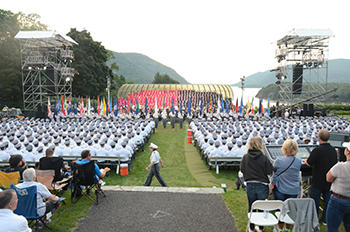
The Mormon Tabernacle Choir, the West Point Band, and the string section from the Orchestra at Temple Square fill the stage at the academy's Trophy Point amphitheater on July 4, 2015. Photo by Debra Gehris.

A military display is part of the program during which the Mormon Tabernacle Choir, the West Point Band, and the string section from the Orchestra at Temple Square fill the stage at the academy's Trophy Point amphitheater on July 4, 2015. Photo by Debra Gehris.
“I just got here a few months ago,” the caller said, “and our lieutenant colonel, the person who’s in charge of the band, has on his bucket list that he wants to play with the Mormon Tabernacle Choir sometime,” the caller said. “He knows I’m a member of the Church, so he has asked me to find out how that could happen.”
Brother Anderson was frank in his reply: “You simply can’t afford us. We can’t fly back to West Point.”
But the thought hit him: The choir would be in New York for the upcoming tour.
“I said, ‘But this could be your lucky year. Tell me about what you do on the Fourth of July.” That was the only open date left on the planned tour.
As it happens, July 4 is when the West Point Band presents its annual Independence Day concert that draws 10,000 to 12,000 people to a picturesque amphitheater called Trophy Point, overlooking the Hudson River. It is also the day when the new class of cadets—the freshman class—are recognized as they formally march in to take their seats in the amphitheater.
The event each year ends with a spectacular fireworks display as boats come up the Hudson.
Brother Anderson suggested the choir could come as guests of the academy and perform with the band. Then the wheels in his head started turning.
He contacted Bob Breitenbeker and Ed Payne, production manager and executive producer of the Music and the Spoken Word weekly broadcast that features the choir and orchestra, with a thought that a television special could be produced from the event.
Last November, the three men traveled to West Point.
“We pitched the idea of doing the special and explained to them that we would like to tell the stories of patriotism and of West Point,” Brother Anderson said.
Academy leaders then referred them to Lt. Col. Sherman L. Fleek, the command military historian at West Point, who is a member of the Church.
Brother Fleek took them on a tour of the academy and acquainted them with its history.
“You need to understand that everybody who is anybody in U.S. military history went to West Point,” Brother Anderson said. “Washington was there during the Revolutionary War. On the west point of the Hudson, they set up barricades at a place where, as the British came up the Hudson, they bombed the boats.”
The army corps of engineers, at Washington’s command, found the deepest point in the river where the boats could be sunk. From that event, West Point traditionally has largely been an academy to train engineers.
“What unfolded to us was all of the history,” Brother Anderson said.
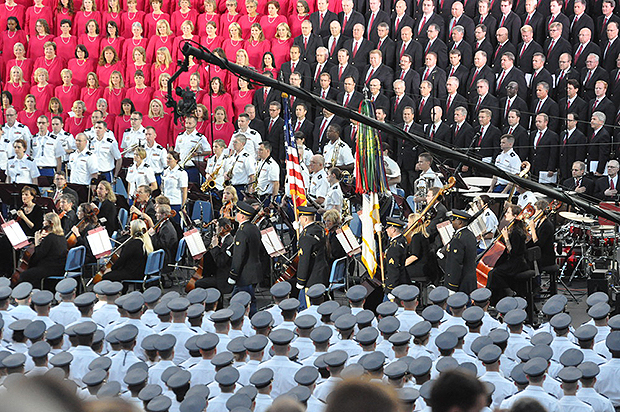
The Mormon Tabernacle Choir, the West Point Band, and the string section from the Orchestra at Temple Square fill the stage at the academy's Trophy Point amphitheater on July 4, 2015. Photo by Debra Gehris.
The primary reason for the secrecy about the choir’s performance there, he said, is that only 10,000 spectators can be accommodated at Trophy Point. The fear was that if word got out that the Mormon Tabernacle Choir was coming, would-be spectators would overrun the venue greatly in excess of the 10,000 that were already expected.
“It would really cause a logistical and security mess for West Point,” Brother Anderson said.
So as it happened, most attendees at the concert were met with the unexpected pleasure of seeing the choir perform there with the West Point Band.
As the entourage of performers and guests arrived on 11 buses July 4, they were met by Brother Fleek.
“Think of some of the people who have marched here, drilled here,” he said, “Douglas McArthur, Eisenhower, Bradley, Jefferson Davis, the president of the Confederacy; Jeb Stuart, Grant, Robert E. Lee, Patraeus, Gen. Pershing. Just think of some of those who have marched across the plain here.”
Several military and civilian personnel at West Point, members of the Church, gave some of the history of the academy at individual stations. One of those was Capt. Rachael Neff, who showed the group Cullum Hall, constructed in 1898, which serves as a memorial to graduates of the academy who died in combat.

At Trophy Point on the grounds of West Point military academy, physics teacher Stacy Godshall shows Tabernacle Choir tour members 13 links of an original 65-ton chain that stretched across the Hudson River to Constitution Island as an obstacle to enemy craft during the Revolutionary War. Photo by R. Scott Lloyd.
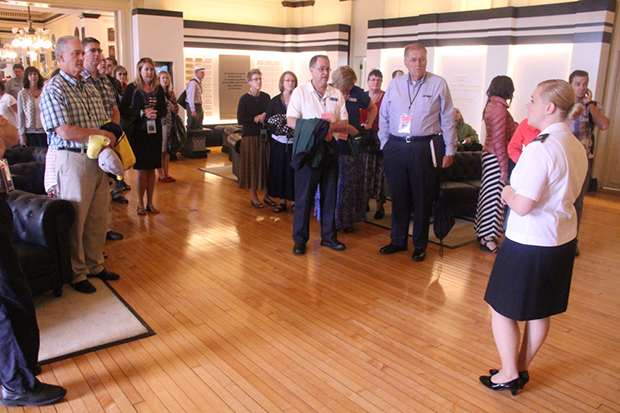
Inside Cullum Hall at West Point military academy, Rachael Neff speaks to Tabernacle Choir tour members about the hall, which serves as a memorial to academy graduates who died in combat. Photo by R. Scott Lloyd.
Sister Neff is a member of the West Point Branch of the Church. In a conversation later, she said that she and two of her friends from the branch, Jody Loveland and Stephanie Holbrook, had gone to New York City two days previously to see the Broadway show Wicked.
“We saw the Mormon Tabernacle Choir crossing the street,” she said. “We saw the dresses and the tuxedos.”
The choir members were going to Carnegie Hall, where they would perform that evening. The branch members knew of the upcoming performance at West Point but had been sworn to secrecy.
“We saw them and said, ‘That’s them! That’s them!’ We were total fan girls. But we couldn’t say anything because they didn’t know they were coming to West Point yet.
“So we knew who it was, and we really wanted to go and say something, but we knew we couldn’t say anything yet. It was a lot of fun to see them.
“We’re really so grateful and blessed to have the choir here. This is such a treat, such a treat.”
Because of the secrecy, choir members were obliged just hours beforehand to learn two of the songs they would perform that evening. One of the songs was “Alma Mater,” a traditional song of West Point. Copies of the sheet music were distributed to the choir members, who studied the pieces during the bus ride from New York City. Later, at sound check rehearsal, they practiced the song with the band.
During free time after lunch at West Point, an impromptu group from the choir joined together to practice “Alma Mater” on their own to prepare for the sound check.
In addition to “Alma Mater,” the choir and the West Point Band, supplemented by the string section from the Orchestra at Temple Square, performed a selection of patriotic songs, including “Stars and Stripes Forever,” “America the Beautiful,” the national anthem, and the choir’s signature piece, “Battle Hymn of the Republic.”
They also performed “Cohan’s Big Three,” the piece the choir had sung without accompaniment the day before at Yankee Stadium. It is a medley featuring songs of Americana from legendary Broadway composer George M. Cohan, including “Yankee Doodle Dandy,” “Give My Regards to Broadway,” and “You’re a Grand Old Flag.”
Mack Wilberg, music director of the choir, and Lt. Col. Andy Esch, director of the West Point Band, shared conducting duties.

The Mormon Tabernacle Choir and West Point cadets prepare to enter Trophy Point amphitheater for the Independence Day celebration at the United States Military Academy July 4, 2015. Photo by R. Scott Lloyd.
The West Point Band has roots extending back to the Revolutionary War, when units of George Washington’s Continental Army, including fifers and drummers, established the garrison of West Point in January of 1778. Today, the band includes the Hellcats, an ensemble of buglers and rudimental drummers that hearkens back to the period of the Revolutionary War, War of 1812, and the Civil War, when drums and bugles played a vital role in battlefield communication. The ensemble today provides musical support to the U.S. Corps of Cadets and serves numerous ceremonial functions.

The Mormon Tabernacle Choir, the West Point Band, and the string section from the Orchestra at Temple Square fill the stage at the academy's Trophy Point amphitheater on July 4, 2015. Photo by Debra Gehris.
“What an amazing experience to be here, with the history of early military standard and training and leaders of the United States—it’s an amazing place,” commented choir president Ron Jarrett. The special to be produced from the performance “will give a united and beautiful message to America about how proud we are to be Americans,” he said.
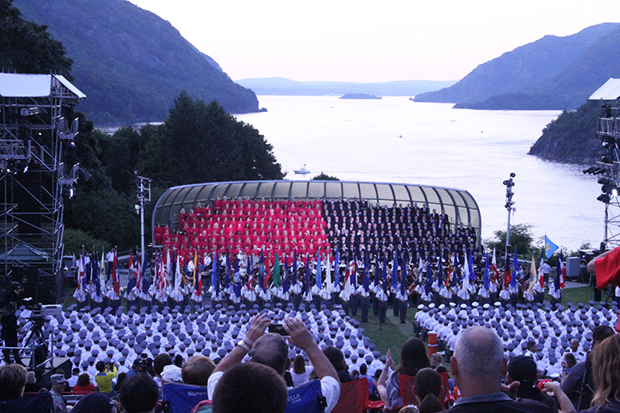
At twilight overlooking the Hudson River, the Mormon Tabernacle Choir, the West Point Band, and the string section from the Orchestra at Temple Square fill the stage at the academy's Trophy Point amphitheater. Photo by R. Scott Lloyd.
